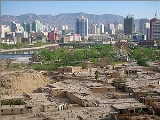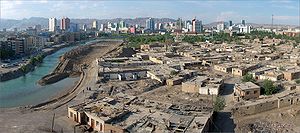
Korla
Encyclopedia
Economy

PetroChina
PetroChina Company Limited is a Chinese oil company and is the listed arm of state-owned China National Petroleum Corporation , headquartered in Dongcheng District, Beijing. It is China's biggest oil producer, and was the world's most valuable company by market value as of September 28th 2010...
's exploration in Xinjiang.
Korla is known for its production of fragrant pear
Pear
The pear is any of several tree species of genus Pyrus and also the name of the pomaceous fruit of these trees. Several species of pear are valued by humans for their edible fruit, but the fruit of other species is small, hard, and astringent....
s—庫爾勒香梨—which are well known in the region for their sweetness and flavor.
Transportation
Korla is served by the national highwaysChina National Highways
The China National Highways are a series of trunk roads throughout all of mainland China. Although they are called highways , they are not necessarily expressways...
G218
China National Highway 218
China National Highway 218 runs from Yining, Xinjiang to Ruoqiang, Xinjiang. It is 1,067 kilometres in length and runs southeast from Yining towards Ruoqiang.-Route and distance:-External links:*...
, G314
China National Highway 314
China National Highway 314 runs southwest from Urumqi, Xinjiang towards Khunjerab Pass, which is the on the northern border of Pakistan and the Xinjiang Autonomous Region of China. It is 1948 kilometres in length....
, the Southern Xinjiang Railway
Southern Xinjiang Railway
The Southern Xinjiang Railway or Nanjiang Railway is a railway between Turpan and Kashgar in Xinjiang, China. The railway is 1,446 km in length and runs along the southern slope of the Tian Shan mountain range, connecting all major cities and towns of the northern Tarim Basin, including Turpan,...
and the Korla Airport.
Communications
As of July 7th, 2009, there was no internet connections and all international telephone communication was cut within the entire province of Xinjiang, including the city of Korla.On October 1st, 2009, a partial relaxing of the internet allowed some Chinese websites to function, but only as "readable" and not "writable".
As of February, 2010, the province is still largely cut from global communications, and tourists from outside of the province and from abroad have complained of a lack of ability to keep in touch with family and friends outside the province.
In May, 2010, internet access was restored to the province.
Demographics
The city had 430,000 inhabitants in 2007, increasing with 20,000 people every year, majority of whom were Han ChineseHan Chinese
Han Chinese are an ethnic group native to China and are the largest single ethnic group in the world.Han Chinese constitute about 92% of the population of the People's Republic of China , 98% of the population of the Republic of China , 78% of the population of Singapore, and about 20% of the...
, with a large minority of Uyghurs
Uyghur people
The Uyghur are a Turkic ethnic group living in Eastern and Central Asia. Today, Uyghurs live primarily in the Xinjiang Uyghur Autonomous Region in the People's Republic of China...
(about 100,000) and smaller numbers of Mongols
Mongols
Mongols ) are a Central-East Asian ethnic group that lives mainly in the countries of Mongolia, China, and Russia. In China, ethnic Mongols can be found mainly in the central north region of China such as Inner Mongolia...
and Hui
Hui people
The Hui people are an ethnic group in China, defined as Chinese speaking people descended from foreign Muslims. They are typically distinguished by their practice of Islam, however some also practice other religions, and many are direct descendants of Silk Road travelers.In modern People's...
s.
History
Korla was known as Weili (尉犁) (reconstructed pronunciation of first character: *i̯wəd) during the Han DynastyHan Dynasty
The Han Dynasty was the second imperial dynasty of China, preceded by the Qin Dynasty and succeeded by the Three Kingdoms . It was founded by the rebel leader Liu Bang, known posthumously as Emperor Gaozu of Han. It was briefly interrupted by the Xin Dynasty of the former regent Wang Mang...
. Weili is said in the Hanshu or 'History of the Former Han' (covering the period 125 BCE to 23 CE), to have had 1,200 households, 9,600 individuals and 2,000 people able to bear arms. It also mentions that it adjoined Shanshan
Shanshan
Shanshan is the Chinese name for a kingdom that existed roughly from 200 BCE-1000 CE at the north-eastern end of the Taklamakan Desert including the great, but now mostly dry, salt lake known as Lop Nur....
and Qiemo (Charchan) to the south.
In 61 CE, the Xiongnu
Xiongnu
The Xiongnu were ancient nomadic-based people that formed a state or confederation north of the agriculture-based empire of the Han Dynasty. Most of the information on the Xiongnu comes from Chinese sources...
led some 30,000 troops from 15 kingdoms including Korla, Karashahr, and Kucha
Kucha
Kuchaor Kuche Uyghur , Chinese Simplified: 库车; Traditional: 庫車; pinyin Kùchē; also romanized as Qiuzi, Qiuci, Chiu-tzu, Kiu-che, Kuei-tzu from the traditional Chinese forms 屈支 屈茨; 龜玆; 龟兹, 丘玆, also Po ; Sanskrit: Kueina, Standard Tibetan: Kutsahiyui was an ancient Buddhist kingdom...
in a successful attack on Khotan
Khotan
Hotan , or Hetian , also spelled Khotan, is the seat of the Hotan Prefecture in Xinjiang, China. It was previously known in Chinese as 于窴/於窴 and to 19th-century European explorers as Ilchi....
.
In 94 CE, the Chinese general Ban Chao
Ban Chao
Ban Chao , courtesy name Zhongsheng , was born in Xianyang, Shaanxi, and the younger brother of the famous historian, Ban Gu who, with his father Ban Biao, and sister, Ban Zhao, wrote the famous Hanshu, or 'History of the Former Han Dynasty'....
sent soldiers to punish the kingdoms of Yanqi (Karashahr), Weixu (Hoxud), Weili(Korla), and Shanguo (in the western Kuruk mountains).
- "He then sent the heads of the two kings of Yanqi (Karashahr) and Weili (Korla) to the capital where they were hung in front of the residences of the Man and Yi princes in the capital (LuoyangLuoyangLuoyang is a prefecture-level city in western Henan province of Central China. It borders the provincial capital of Zhengzhou to the east, Pingdingshan to the southeast, Nanyang to the south, Sanmenxia to the west, Jiyuan to the north, and Jiaozuo to the northeast.Situated on the central plain of...
). (Ban) Chao then appointed Yuan Meng, who was the Yanqi (Karashahr) Marquis of the Left, king (of Kashgar). The kings of Weili (Korla), Weixu (Hoxud), and Shanguo (in the western Kuruk mountains) were all replaced."
After the rebellion of the "Western Regions
Western Regions
The Western Regions or Xiyu was a historical name specified in the Chinese chronicles between the 3rd century BC to 8th century AD that referred to the regions west of Jade Gate, most often Central Asia or sometimes more specifically the easternmost portion of it The Western Regions or Xiyu was a...
" (106-125 CE), only the kings of Korla and Hoxud refused to submit to the Chinese. Ban Yong
Ban Yong
Ban Yong ) was the youngest son of the famous Chinese General, Ban Chao , and the nephew of the illustrious historian, Ban Gu who compiled the Hanshu, the dynastic history of the Former Han dynasty.- Ban Yong's family :...
, the son of Ban Chao
Ban Chao
Ban Chao , courtesy name Zhongsheng , was born in Xianyang, Shaanxi, and the younger brother of the famous historian, Ban Gu who, with his father Ban Biao, and sister, Ban Zhao, wrote the famous Hanshu, or 'History of the Former Han Dynasty'....
, along with the Governor of Dunhuang
Dunhuang
Dunhuang is a city in northwestern Gansu province, Western China. It was a major stop on the ancient Silk Road. It was also known at times as Shāzhōu , or 'City of Sands', a name still used today...
, attacked and defeated them.

Weilüe
The Weilüe written by Yu Huan between CE 239, the end of Emperor Ming’s reign, and 265 CE, the end of the Cao Wei . Although not an "official historian," Yu Huan has always been held in high regard amongst Chinese scholars....
records that Korla, Hoxud and Shanwang (Shanguo) were all dependencies of Karashahr. In May, 1877 Yakub Beg
Yakub Beg
Muhammad Yaqub Bek was a [Turkic peoples] adventurer who became head of the kingdom of Kashgaria.-Spelling variants:In English-language literature, the name of Yaqub Beg has also been spelt as Yakub Beg , Yakoob Beg , or Ya`qūb Beg...
, the Muslim ruler of Kashgaria, died here, prompting the reconquest of Kashgaria by the Qing dynasty
Qing Dynasty
The Qing Dynasty was the last dynasty of China, ruling from 1644 to 1912 with a brief, abortive restoration in 1917. It was preceded by the Ming Dynasty and followed by the Republic of China....
.
Francis Younghusband
Francis Younghusband
Lieutenant Colonel Sir Francis Edward Younghusband, KCSI, KCIE was a British Army officer, explorer, and spiritual writer...
, passed through "Korlia" in 1887 on his overland journey from Beijing
Beijing
Beijing , also known as Peking , is the capital of the People's Republic of China and one of the most populous cities in the world, with a population of 19,612,368 as of 2010. The city is the country's political, cultural, and educational center, and home to the headquarters for most of China's...
to India
India
India , officially the Republic of India , is a country in South Asia. It is the seventh-largest country by geographical area, the second-most populous country with over 1.2 billion people, and the most populous democracy in the world...
. He described it as being prosperous and the country round about well-cultivated, with more land under cultivation than any other town he had passed. Maize
Maize
Maize known in many English-speaking countries as corn or mielie/mealie, is a grain domesticated by indigenous peoples in Mesoamerica in prehistoric times. The leafy stalk produces ears which contain seeds called kernels. Though technically a grain, maize kernels are used in cooking as a vegetable...
seemed to be the major crop but rice was also grown. There was a small Chinese town, about 400 yards (365.8 m) square with mud walls about 35 feet (10.7 m) high and with a ditch. There were round bastions at the angles, but none at the gateway. A mile (1.6 km) south was the Turk town, but its walls were in ruins. It had one main street about 700 yards (640.1 m) long. "The shops are somewhat better than at Karashar, but not so good as at Turfan."
See also
- The detailed histories listed under KashgarKashgarKashgar or Kashi is an oasis city with approximately 350,000 residents in the western part of the Xinjiang Uyghur Autonomous Region of the People's Republic of China. Kashgar is the administrative centre of Kashgar Prefecture which has an area of 162,000 km² and a population of approximately...
, KhotanKhotanHotan , or Hetian , also spelled Khotan, is the seat of the Hotan Prefecture in Xinjiang, China. It was previously known in Chinese as 于窴/於窴 and to 19th-century European explorers as Ilchi....
and Yarkand.

